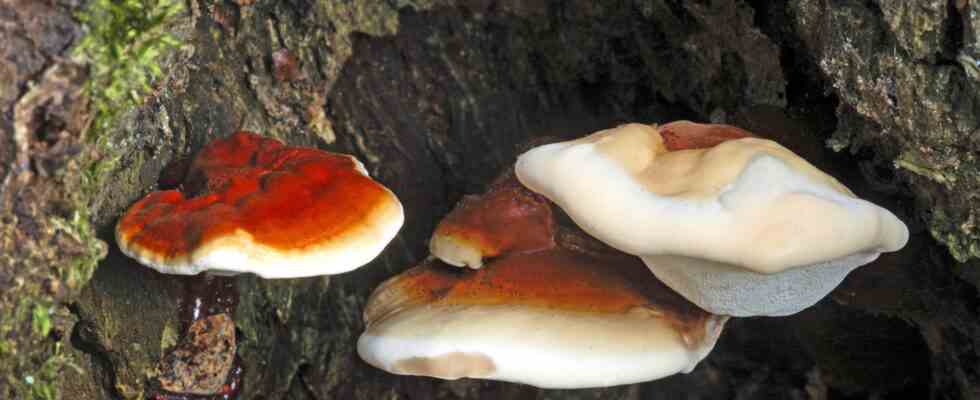Status: 01/15/2023 11:52 a.m
The glossy lacquer polypore can do more than just infest trees. Researchers have succeeded in producing a living robot skin and a sustainable alternative for chips and batteries from the fungus.
The more technologies are used today, the more the question arises as to how they can be made more robust and at the same time more sustainable. After all, vacuum cleaning robots, smartphones or computer circuit boards also have to be disposed of at some point. Sustainable alternatives made from plants or fungi could help here.
For example, Austrian researchers have developed a printed circuit board based on the commonly occurring tree fungus Shiny Lackporling, as published in the specialist journal Science Advances published.
Circuit boards made from tree fungus
Printed circuit boards serve as carriers for electronic components and connect them to one another by so-called conductor tracks. The plate itself is made of a stable and electrically insulating material, mostly plastic or silicon. The fungus, on the other hand, can produce biodegradable electronic circuit boards, which decompose themselves within a very short time within a few weeks.
This is made possible by so-called fungal mycelia. These are the root networks of fungi, which in nature have huge subterranean networks of fibers. The mycelial skin is used for the printed circuit boards. The skin of the mushroom mycelia is both heat-resistant, robust and flexible.
The skin of the Glossy Varnish Porling is robust and versatile.
Image: picture alliance / dpa theme die
Simple and resource-saving production
Production begins with beech shavings, wholemeal spelled flour, plaster and water – and with spores of the glossy lacquer polypore. The research team from the Johannes Kepler University Linz allowed the mycelium to grow on it. In the last step, the skin was then pulled off the mycelium, dried and pressed and cut to the right size. Conductor tracks can then be added and electronic components can be attached as with conventional printed circuit boards.
According to the research team, printed circuit board production is easier, requires less energy and water than conventional production and does not use harmful chemicals. So far, it has been possible to produce simple and small printed circuit boards.
The researchers also use the fungal mycelia to make batteries. In such a battery, both the membrane between the poles and the shell can consist of the mycelium of the lacteal polypore.
Mushroom mycelium – a complex and adaptive network
In addition to the properties of the mycelial skin in electronics, the mycelium itself can also be of interest to science. Because the fungal mycelium is a living, complex and adaptable material that forms large networks. These networks are in turn made up of elongated cells called hyphae. The hyphae absorb water and nutrients, which is how the fungus spreads in nature.
In most of the previously known application approaches, however, the fungi used die at the end of the process or are removed again. Researchers at the Swiss Federal Institute of Technology in Zurich are now also using the adaptive behavior to develop a self-healing and robust robot skin.
Living robot skin from the 3D printer
Like the research team in the journal Nature Materials describes, a three-dimensional grid is printed from a hydrogel in a 3D printer. The hydrogel is loaded with spores of the glossy lacquer polypore. If the scaffold is left for several days at 23 degrees Celsius and a high relative humidity of 95 percent, the mycelium grows without the hydrogel drying out.
Within 20 days, the fungal mycelia colonize the printed grid, resulting in a robust and regenerating skin. If this is cut through or punctured, it grows back together. Responsible for this is the metabolic activity of the mycelia and the availability of nutrients.
Robot wetted with mycelium
The living robot skin made of mycelium is soft, waterproof, regenerative and robust against mechanical influences. Thus, the properties of the skin through the mycelium are comparable to some of the functions of biological animal skins.
The researchers conducted tests using a robotic arm and a ball robot covered with a skin made of mycelium. The robots successfully completed underwater actions or were rolled over different surfaces.
Further research approaches and possible areas of application
Both research approaches show that the use of fungal mycelia is still in its infancy. For example, complex printed circuit boards are to be made from smoother mycelial skin in the future, and there is also a need for further research in order to be able to keep the metabolic activity and thus the living robot skin alive in the long term.
But research is also being carried out with the mushroom mycelium beyond electronics and robotics, for example for sustainable insulation and building materials or for a hard-wearing alternative to leather.

